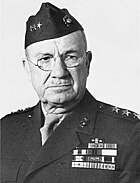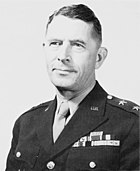WW II battle involving Japan and the United States
On 15 June 1944, United States Marine forces landed on the southwest coast of the island of Saipan Marianas chain; these were followed a day later by US Army forces. This invasion was part of Operation Forager Empire of Japan .
The island had been a Japanese possession since it was captured by the Imperial Japanese Army during World War I . As military conflict with the United States became increasingly likely during the 1930s, Japan expended great effort in fortifying Saipan. In mid-1944, nearly 30,000 troops were based on the island, almost double the estimates of US intelligence.[ 1]
US forces declared Saipan secure on 9 July 1944.
United States
Vice Adm. Richmond Kelly Turner
Naval forces
United States Pacific Fleet [ 2] Chester W. Nimitz Pearl Harbor
United States Fifth Fleet Admiral Raymond A. Spruance Indianapolis Joint Expeditionary Force (Task Force 51) Vice Admiral Richmond Kelly Turner Rocky Mount Northern Attack Force (Task Force 52 – Saipan and Tinian) Vice Admiral Turner Southern Attack Force (Task Force 53 – Guam) Vice Admiral Richard L. Conolly in amphibious command ship Appalachian
Ground forces
Lieut. Gen. Holland M. Smith
US warships prepare to depart Roi for Saipan. Expeditionary Troops (Task Force 56) Holland M. "Howlin' Mad" Smith [ a]
Chief of Staff: Brig. Gen. Graves B. Erskine [ b]
Personnel Officer (G-1): Lt. Col. Albert F. Metze
Intelligence Officer (G-2): Col. St. Julien R. Marshall
Operations Officer (G-3): Col. John C. McQueen
Logistics Officer (G-4): Col. Raymond E. Knapp
Plans Officer (G-5): Col. Joseph T. Smith
Northern Troops and Landing Force (Task Group 56.1 – Tinian and Saipan) Consisting of V Amphibious Corps
Southern Troops and Landing Force (Task Group 56.2 – Guam) Consisting of III Amphibious Corps V Amphibious Corps Holland M. Smith [ c]
Chief of Staff: Brig. Gen. Graves B. Erskine
XXIV Corps Artillery (Brig. Gen. Arthur M. Harper )
1st Provisional Gun Group
225th Field Artillery Howitzer Group
Maj. Gen. Thomas E. Watson
Brig. Gen. Merritt A. Edson
Left beaches
2nd Marine Division asst. cmdr. Merritt A. Edson confers with 8th Marine Regiment officers James P. Riseley and Kenneth F. McLeod on Saipan. Marines digging in on the beach at Saipan. 2nd Marine Division Major General Thomas E. Watson
Asst. Div. Cmdr.: Brig. Gen. Merritt A. Edson
Red beaches
6th Marine Regiment Commanding Officer: Col. James P. Riseley
Executive Officer: Lt. Col. Kenneth F. McLeod
1st Battalion (Lt. Col. William K. Jones )2nd Battalion (Lt. Col. Raymond L. Murray )3rd Battalion (Lt. Col. John W. Easley) Green beaches
8th Marine Regiment Commanding Officer: Col. Clarence R. Wallace
Executive Officer: Lt. Col. Jack P. Juhan
1st Battalion (Lt. Col. Lawrence C. Hays Jr.)2nd Battalion (Lt. Col. Henry P. Crowe )3rd Battalion (Lt. Col. John C. Miller Jr. ) Floating reserve
2nd Marine Regiment Commanding Officer: Col. Walter J. Stuart
Executive Officer: Lt. Col. John H. Griebel
1st Battalion (Lt. Col. Wood B. Kyle )2nd Battalion (Lt. Col. Richard C. Nutting)3rd Battalion (Lt. Col. Arnold F. Johnston) Landed after D-Day
10th Marine Regiment (Artillery) Commanding Officer: Col. Raphael Griffin
Executive Officer: Lt. Col. Ralph E. Forsyth
1st Battalion (Lt. Col. Presley M. Rixey)2nd Battalion (Lt. Col. George R. E. Shell )3rd Battalion (Maj. William L. Crouch)4th Battalion (Lt. Col. Kenneth A. Jorgensen)
18th Marine Regiment (Engineer) Commanding Officer: Lt. Col. Ewart S. Laue
1st Battalion, 18th Marines (Lt. Col. August L. Vogt)
2nd Battalion, 18th Marines (Lt. Col. Chester J. Salazar)
Attached units
1st Battalion, 29th Marine Regiment (Lt. Col. Guy E. Tannyhill; Lt. Col. Rathvon M. Tompkins ; Lt. Col. Jack P. Juhan )[ 5]
715th Amphibian Tractor Battalion (Army)
Brig. Gen. Samuel C. Cumming
Right beaches
Two Marines crawl to their assigned positions on the beach on Saipan. African-American Marine ammunition carriers on Saipan. Two Marine PFCs display the bazooka they used to disable Japanese tanks on Saipan. 4th Marine Division Major General Harry Schmidt
Asst. Div. Cmdr.: Brig. Gen. Samuel C. Cumming
Blue beaches
23rd Marine Regiment Colonel Louis R. Jones
Exec. Ofc.: Lt. Col. John R. Lanigan
1st Battalion (Lt. Col. Ralph Haas )2nd Battalion (Lt. Col. Edward J. Dillon)3rd Battalion (Maj. John J. Cosgrove) Yellow beaches
25th Marine Regiment Colonel Merton J. Batchelder
Exec. Ofc.: Lt. Col. Clarence J. O'Donnell
1st Battalion (Lt. Col. Hollis U. Mustain)2nd Battalion (Lt. Col. Lewis C. Hudson )3rd Battalion (Lt. Col. Justice M. Chambers ) Floating reserve
24th Marine Regiment Colonel Franklin A. Hart
Exec. Ofc.: Lt. Col. Austin R. Brunelli
1st Battalion (Lt. Col. Robert N. Fricke)2nd Battalion (Lt. Col. Richard Rothwell)3rd Battalion [ d] Otto Lessing ) Landed after D-Day
14th Marine Regiment (Artillery) Colonel Louis G. DeHaven
Exec. Ofc.: Lt. Col. Randall M. Victory
1st Battalion (Lt. Col. Harry J. Zimmer)2nd Battalion (Lt. Col. George B. Wilson Jr.)3rd Battalion (Maj. Robert E. MacFarlane)4th Battalion (Lt. Col. Carl A. Youngdale )
20th Marine Regiment (Engineer) Lt. Colonel Nelson K. Brown
Exec. Ofc.: Capt. William M. Anderson
1st Battalion (Maj. Richard G. Ruby)2nd Battalion (Maj. John H. Partridge) Attached units
708th Amphibian Tank Battalion (Army)
773rd Amphibian Tractor Battalion (Army)
534th Amphibian Tractor Battalion (Army)
US Army soldiers disembark from LSTs on Saipan. 27th Infantry Division (Army) Major General Ralph C. Smith [ e]
Major General Sanderford Jarman (24 Jun thru 28 Jun)
Major General George W. Griner (after 28 Jun)
Blue beaches
Infantry
105th Infantry Regiment
106th Infantry Regiment
165th Infantry Regiment Artillery
104th Field Artillery Battalion
105th Field Artillery Battalion
106th Field Artillery Battalion
249th Field Artillery Battalion Armor
762nd Tank Battalion
766th Tank Battalion Engineer
102nd Engineer Combat Battalion
502nd Engineer Combat Battalion Navy
UDT 5UDT 6
Japan
Lt. Gen. Yoshitsugu Saito
A captured Mitsubishi A6M5 Zero fighter at a Japanese airfield on Saipan. Central Pacific Area Fleet HQ [ 6] Chūichi Nagumo
Thirty-first Army [ f] Lieutenant General Hideyoshi Obata
14th Air Fleet
Defenses of Saipan Lieutenant General Yoshitsugu Saito
Approx. 25,500 army and 6,200 navy personnel
43rd Division
118th Infantry Regiment
135th Infantry Regiment
136th Infantry Regiment Divisional support
47th Independent Mixed Brigade
316th Independent Infantry Battalion
317th Independent Infantry Battalion
318th Independent Infantry Battalion Other units
3rd Independent Mountain Artillery Regiment
9th Tank Regiment (of 1st Tank Division )
3rd Battalion, 9th Independent Mixed Regiment
1st Battalion, 18th Infantry Regiment 25th Antiaircraft Artillery Regiment
7th Independent Engineer Battalion
14th Independent Mortar Battalion
17th Independent Mortar Battalion
Miscellaneous straggler units
See also
Orders of battle involving United States Marine forces in the Pacific Theatre of World War II :
Notes
^ Generated so much ill will between the armed services in the Pacific Theater that he had to be relieved of command in July 1945.[ 3]
^ Commanded 3rd Marine Division on Iwo Jima .
^ Assigned to command of Fleet Marine Force, Pacific , an umbrella command of all Marine Corps forces in the Pacific Theater .[ 4]
^ Pvt. Lee Marvin , later a prominent Hollywood actor, was wounded while serving in Company I of this unit during the struggle for Mount Tapochau .
^ Relieved of command and expelled from the island by Lt. Gen. Holland Smith for allowing his troops to fall behind the Marine Corps advance up the island.
^ A Japanese army was equivalent to a Euro-American corps.
References
^ Rottman, p. 42
^ Rottman, p. 35
^ Rottman, p. 31
^ Rottman, p. 28
^ Johnston, Goldberg
^ Rottman, p. 91
Bibliography
Clark, George B. (2006). The Six Marine Divisions in the Pacific: Every Campaign of World War II . Jefferson, North Carolina: McFarland and Co. ISBN 978-0-7864-2769-7 Goldberg, Harold J. (2007). D-Day in the Pacific: The Battle of Saipan . Indiana University Press. ISBN 978-0-25334-869-2 Johnston, Richard W. (1987). Follow Me: The Story of the Second Marine Division in World War II . Battery Press. ISBN 0-89839-099-0 Morison, Samuel Eliot (1953). New Guinea and the Marianas, March 1944 – August 1944 . History of United States Naval Operations in World War II. Vol. VIII. Boston: Little, Brown and Co. LCCN 53-7298 . Rottman, Gordon; Howard Gerrard (2004). Saipan & Tinian 1944: Piercing the Japanese Empire . Oxford: Osprey Publishing. ISBN 1-84176-804-9
External links




















